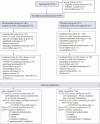Randomized Study of Rivaroxaban vs Placebo on Disease Progression and Symptoms Resolution in High-Risk Adults With Mild Coronavirus Disease 2019
- PMID: 34523673
- PMCID: PMC8522357
- DOI: 10.1093/cid/ciab813
Randomized Study of Rivaroxaban vs Placebo on Disease Progression and Symptoms Resolution in High-Risk Adults With Mild Coronavirus Disease 2019
Abstract
Background: Severe acute respiratory syndrome coronavirus 2 infection may be associated with a prothrombotic state, predisposing patients for a progressive disease course. We investigated whether rivaroxaban, a direct oral anticoagulant factor Xa inhibitor, would reduce coronavirus disease 2019 (COVID-19) progression.
Methods: Adults (N = 497) with mild COVID-19 symptoms and at high risk for COVID-19 progression based on age, body mass index, or comorbidity were randomized 1:1 to either daily oral rivaroxaban 10 mg (N = 246) or placebo equivalent (N = 251) for 21 days and followed to day 35. Primary end points were safety and progression. Absolute difference in progression risk was assessed using a stratified Miettinen and Nurminen method.
Results: The study was terminated after 497 of the target 600 participants were enrolled due to a prespecified interim analysis of the first 200 participants that crossed the futility boundary for the primary efficacy end point in the intent-to-treat population. Enrollees were 85% aged <65 years; 60% female; 27% Hispanic, Black, or other minorities; and 69% with ≥2 comorbidities. Rivaroxaban was well tolerated. Disease progression rates were 46 of 222 (20.7%) in rivaroxaban vs 44 of 222 (19.8%) in placebo groups, with a risk difference of -1.0 (95% confidence interval, -6.4 to 8.4; P = .78).
Conclusions: We did not demonstrate an impact of rivaroxaban on disease progression in high-risk adults with mild COVID-19. There remains a critical public health gap in identifying scalable effective therapies for high-risk people in the outpatient setting to prevent COVID-19 progression.
Keywords: COVID-19; SARS-CoV-2; infection; pneumonia; rivaroxaban.
© The Author(s) 2021. Published by Oxford University Press for the Infectious Diseases Society of America.
Figures



References
Publication types
MeSH terms
Substances
LinkOut - more resources
Full Text Sources
Miscellaneous

